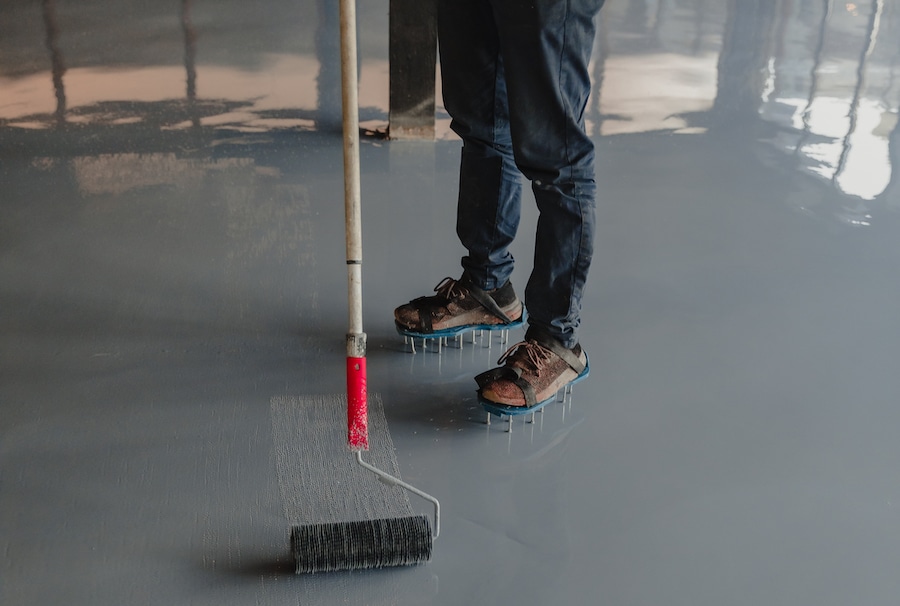Epoxy Garage Floors vs. Painted Garage Floors: Which is Better?
When it comes to epoxy garage floors vs. painted garage floors, the two options can seem like they share more similarities than differences, making it difficult to choose the one that makes more sense for your garage.
In this article, we talk through their differences and similarities, including everything you need to know to make the best decision:
- What epoxy flooring is
- The benefits of epoxy flooring
- The different types of epoxy flooring
- What painted garage flooring is
- The benefits of painted garage flooring
- The different types of paint used on garage floors
- The most important factors to consider when choosing between the two
What is Epoxy Garage Flooring?
Epoxy flooring has long been popular in industrial and commercial spaces such as hospitals, schools, and factories, and has gained traction in homes due to its durability, stain resistance, and anti-slip features.
Epoxy flooring is a mix of a resin and hardening chemical that is applied to an existing concrete floor. After being poured, the epoxy coating hardens to form an attractive, easy-to-clean surface.
There are lots of reasons homeowners choose an epoxy coating for their garage floor, including:
- Durability: By nature of the materials used, epoxy-coated floors are highly durable and can withstand heavy traffic and wear and tear. In fact, an epoxy coating can easily last 20 years or more when properly cared for.
- Easy to Clean: Unlike a standard concrete floor, which will absorb spills and result in oil stains, an epoxy coating offers an incredible level of stain resistance. Just mop the floor, and it’ll look brand new again.
- Appearance: Epoxy flooring comes in a wide variety of colors and finishes, making it easy to choose one that looks great in your home garage.
- Anti-Slip Features: Epoxy-coated floors are by nature fairly anti-slip, especially when compared to uncoated or polished concrete. For even better anti-slip functionality, consider a chip epoxy (more on that below).

Most Common Types of Epoxy for Garage Flooring
Choosing the type of epoxy to use in your garage is the most important decision you’ll make during this process because it dictates what the finished product will look like.
There are three most commonly used types of epoxy coatings used for garage flooring: clear coating, solid coating, and chip (or flaked) coating:
- Clear Coating: A clear coating comes with all the benefits of an epoxy coating, but doesn’t add color or design to your existing flooring. A clear coat is an excellent choice if you’re happy with the look of your existing flooring, but want to keep it looking great for years to come.
- Opaque Coating: An opaque coating is a solid color of your choice. A solid-colored epoxy coating is a great choice because, unlike paint, the color will remain true and vibrant as the floor ages.
- Chip Epoxy Coating: Also known as flake epoxy, chip epoxy coating incorporates vinyl flakes into the epoxy blend, dramatically improving the flooring’s anti-slip qualities. A chip epoxy coating is perfect if anti-slip flooring is important to you.

What is Painted Garage Flooring?
Painting your garage floor is very different from an epoxy coating. While an epoxy coating is a thick layer of resin and hardening chemical, paint is a much thinner layer applied with a standard paint roller.
Painting your garage floor has obvious benefits, most significantly its simple application and low upfront cost—doable by the savvy DIY homeowner.
When painting your garage floor, there are two types of paint to choose from: acrylic latex-based paint or an epoxy-based paint:
- Acrylic Latex-Based Paint is commonly used for a variety of home projects, including exterior surfaces, masonry, furniture, and siding. It’s known for its simple application and low cost. When painting a garage floor with acrylic latex-based paint, you can expect it to last about two years (so if you go this route, plan to repaint your floor in a couple of years).
- Epoxy-Based Paint is typically a latex acrylic paint product that has a small amount of epoxy in it—and is not the same as an epoxy coating. An epoxy-based paint is applied with a paint roller and dries like any other paint product, creating a thin layer on the existing surface. An epoxy coating, on the other hand, is installed by a professional contractor, and must then cure to create an entirely new surface atop the existing floor. When using an epoxy-based paint, you can anticipate it lasting roughly 3-4 years.
Epoxy Coating vs. Painted Garage Floor: Which is Best for You?
Painting your garage floor is very different from an epoxy coating. While an epoxy coating is a thick layer of resin and hardening chemical, paint is a much thinner layer applied with a standard paint roller.
Painting your garage floor has obvious benefits, most significantly its simple application and low upfront cost—doable by the savvy DIY homeowner.
When painting your garage floor, there are two types of paint to choose from: acrylic latex-based paint or an epoxy-based paint:
- Acrylic Latex-Based Paint is commonly used for a variety of home projects, including exterior surfaces, masonry, furniture, and siding. It’s known for its simple application and low cost. When painting a garage floor with acrylic latex-based paint, you can expect it to last about two years (so if you go this route, plan to repaint your floor in a couple of years).
- Epoxy-Based Paint is typically a latex acrylic paint product that has a small amount of epoxy in it—and is not the same as an epoxy coating. An epoxy-based paint is applied with a paint roller and dries like any other paint product, creating a thin layer on the existing surface. An epoxy coating, on the other hand, is installed by a professional contractor, and must then cure to create an entirely new surface atop the existing floor. When using an epoxy-based paint, you can anticipate it lasting roughly 3-4 years.
Cost & Installation
In terms of upfront cost, painting your garage floor is the cheaper option. The cost of paint is significantly lower than epoxy, and applying paint is DIY-friendly for the average homeowner.
When planning for the long term, keep in mind that when opting for painted garage floors, they’ll need to be redone every 2-5 years to keep them looking great while effectively protecting your concrete flooring. This is where an epoxy coating shines—because while the upfront cost is higher, once installed, you won’t have to worry about it again for at least 20 years.

Durability & Maintenance
An epoxy garage floor is significantly more durable and will look great for the next 20 years. Epoxy is resistant to stains, scuffs, scratches, and spills—sweeping and/or mopping the epoxy surface will return it to looking brand new.
As we mentioned earlier, a painted garage floor is significantly less durable, and will last only the fraction of a time that an epoxy floor will. Additionally, a painted floor is susceptible to scratches, spills, and even cracking or chipping over time. Additionally, the level of traffic your floor experiences will directly impact its durability—making a painted floor more suited for low-traffic areas.
The other factor to consider when it comes to durability is moisture resistance—more specifically, how well your new garage floor will hold up in Austin’s subtropical humid climate. Epoxy flooring is better suited to humid environments because it will repel moisture more effectively than a painted floor.
Overall Appearance
The biggest difference in appearance between a painted or epoxied floor will depend on the type of epoxy coating used. When using an epoxy, you can choose between clear, solid, or chip epoxy coatings, each of which will give your flooring a distinctly different look. With paint, however, you’ll have fewer options, and your choice will be mostly limited to which solid color to use.
Either a painted or an epoxy garage floor will look great when freshly installed, but, as we mentioned, one of the biggest considerations is how long after installation your new floor will continue to look great (i.e., durability).
PS: If you don't think an epoxy floor is for you, check out our complete guide to concrete polishing for some other ideas.
